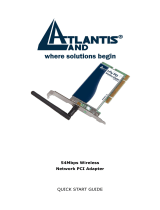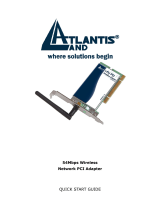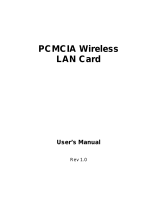Page is loading ...

TEW401_403
Wireless LAN 802.11g NIC Series
User’s Guide
Version 1.1
User’s Guide
0

Copyright statement
No part of this publication may be reproduced, stored in a retrieval system, or transmitted in any form
or by any means, whether electronic, mechanical, photocopying, recording, or otherwise without the
prior writing of the publisher.
July. 2003
User’s Guide
1

Contents
1. Introduction............................................................................................................... 3
2. Wireless LAN Basics ................................................................................................ 4
3. Installation for Windows platform ........................................................................... 5
3.1. Installation Overview…………………………………………………………………………………..6
3.2. Install Procedure for Windows XP……………………………………………………….7
3.3. Install Procedure for Windows 98/ME/2000…………………………………………….9
4. Configuration Utility ............................................................................................... 17
4.1 Link Information…………………………………………………………………………………………19
4.2 Availiable Network…………………………………………………………………………21
4.3 Profile Setting……………………………………………………………………………………………22
4.4 About………………………………………………………………………………………………………26
5. Troubleshooting...................................................................................................... 27
User’s Guide
2

1. Introduction
Thank you for purchasing your Wireless LAN 802.11g Adapter. This Quick Installation Guide will assist
you with the installation procedure.
The package you have received should contain the following items:
• Wireless LAN 802.11g Adapter
• Quick Installation Guide
• CD containing Wireless LAN Management utility, drivers and Multi-lingual User’s Guide
Note: if anything is missing, please contact your vendor
The CD contains drivers and Configuration Utility program that is used for managing the Wireless LAN
Adapters and establishing the wireless connection with your Local Area Network.
Note: This manual is valid for all Wireless LAN 11g Series products, such as PC Card, USB, mini-USB,
PCI adapter, mini-PCI…etc.
User’s Guide
3

2. Wireless LAN Basics
Wireless LAN (Local Area Networks) systems offer a great number of advantages over a traditional,
wired system. Wireless LANs (WLANs) are more flexible, easier to setup and manage and often more
cost effective than their wired equivalence.
Using radio frequency (RF) technology, WLANs transmit and receive data over the air, minimizing the
need for wired connections. Thus, WLANs combine data connectivity with user mobility, and, through
simplified configuration, enable movable LANs.
With wireless LANs, users can access shared information without looking for a place to plug in and
network managers can set up or augment networks without installing or moving wires. Wireless LANs
offer the following productivity, convenience and cost advantages over traditional wired networks:
• Mobility - Wireless LAN systems can provide LAN users with access to real-time information
anywhere in their organization. This mobility supports productivity and service opportunities not
possible with wired networks.
• Installation Speed and Simplicity - Installing a wireless LAN system can be fast and easy and can
eliminate the need to pull cable through walls and ceilings.
• Installation Flexibility - Wireless technology allows the network to go where wires cannot go.
• Reduced Cost-of-Ownership - While the initial investment required for wireless LAN hardware
might be higher than the cost of wired LAN hardware, overall installation expenses and life-cycle
costs will be significantly lower. Long-term cost benefits are greatest in dynamic environments
requiring frequent moves, adds, and changes.
• Scalability - Wireless LAN systems can be configured in a variety of topologies to meet the needs
of specific applications and installations. Configurations are easily changed and range from peer-
to-peer to full infrastructure networks, also allow roaming over a broad area.
User’s Guide
4

3. Installation for Windows platform
The following section will assist you in installing wireless LAN Adapter successfully. You will first install
software (Utility) and then insert / attach the Wireless LAN Adapter to your system, and finally set the
network properties to accommodate resource sharing and select the type of wireless network that you
wish to install. The Wireless LAN card can easily be installed and used, without bothering to connect
cables for keeping your computer to use network resources.
User’s Guide
5

3.1. Installation Overview
Here are some steps you will perform in establishing your wireless network connection:
z Install the Access Point at first. AP is needed in case of Infrastructure network mode.
z Install the software using the Install CD.
z Install the Wireless LAN Card (WIRELESS LAN 802.11g Adapter).
z Install the network protocol(s) required to communicate on your network. Most likely you will need
the TCP/IP protocol.
User’s Guide
6

3.2. Install Procedure for Windows XP
Important Notice
In order to make right use of WPA, please ensure that your current Wireless Adapter’s driver, and
Wireless Utility can support it, WPA needs 802.1x authentication (when RADIUS mode is chosen),
though the Operating System must also support 802.1x protocol. For Microsoft’s OS family, only
Windows XP has incorporated this by default. The rest of the OS must installed 3er party’s client
software such as Funk ODySSey.
Note: Do not insert the WLAN Adapte
r
until you are asked to do so, failure of which may result in unsuccessful
installation of your WLAN device.
1. Insert the given Installation CD in the CD-ROM and then click on the Install Config Utilities.
Follow the instruction to finish the installation.
2. Insert your WLAN card into PCMCIA/PCI slot or USB connector of your system, and then system
will detect new hardware.
Select “Install the software automatically (Recommended) ”, and then click Next to continue.
User’s Guide
7

Once your system detected the driver, Microsoft will show a warning message as below.
Click “ Continue Anyway ” for next step.
After copy the file to your system, then the setup is finish.
User’s Guide
8

3.3. Install Procedure for Windows 98/ME/2000
Note: Do not insert the WLAN Adapte
r
until you are asked to do so, failure of which may result in unsuccessful
installation of your WLAN device.
Please follow the following steps one by one in order to install the WLAN
Adapter successfully.
1. Power on your computer and allow Windows 98/ME/2000 to load fully.
2. Be sure that the Wireless LAN 802.11g Adapter is not inserted yet.
3. Insert the given Installation CD in the CD-ROM and then click on the Install Config Utilities.
At the “ Welcome” window, click Next.
User’s Guide
9

4. Accept the license agreement.
Accept the license agreement. Click Yes to accept.
Click Yes to finish the setup.
User’s Guide
10

5. Insert / attach Wireless LAN 802.11g Adapter to your system
Windows will recognize the WLAN adapter and auto detect the driver, if the system did not find the
driver automatically, please install the driver manually.
Click Yes to finish the installation.
User’s Guide
11

6. Click the right button of mouse on My Computer Æ Properties Æ HardwareÆDevice Manager.
Check whether it has WLAN adapter in one of the sockets or not. If you find Wireless Network PC
Card in one of the sockets, it means the card is detected properly.
7. Click right button of mouse on the Network Neighborhood.
User’s Guide
12

8. Select Properties from the pop up menu. For Windows 98 the network’s properties box appears.
* For Windows ME and 2000, please select the Local Area Connection’s properties to check the
following menu.
9. Click on the General tab and then click on the Install button. Select Network Component Type box
appears. Click on the Protocol then click the Add button.
User’s Guide
13

10. Select Network Protocols box appears. From the list of network protocols list, select NetBEUI, then
click OK.
11. The NetBEUI protocol is now installed. After clicking on OK return back to Network Component
Type box.
12. Repeat the step 9 and 10 to add IPX/SPX protocol.
User’s Guide
14

13. Click on the TCP/IP option for setting the IP address for your computer. You can select either
Obtain an IP address automatically or Use the following IP address setting. If your choice is the
second one then enter the IP value, Subnet masking, DNS, Domain/ Workgroup name, and
Gateway Address values. After setting these parameters appropriately, click OK to return to
Network Component Type and you can select the File and Printer Sharing options as well for
sharing your computers resources. Click on OK.
14. Screen message do want to restart your Computer will pop up. Select Yes. It will shut down your
computer and restart.
Important: In order to make sure that the changed values could take effect, please Restart
your computer before continue.
User’s Guide
15

Uninstall Procedure
Step 1:
If you want to uninstall the WLAN adapter, just simply click
Start Menu Æ Program Æ Wireless Network Æ Uninstall,
it shall uninstall all related programs.
Step 2:
Restart your Computer.
User’s Guide
16

4. Configuration Utility
Wireless LAN 802.11g Wireless LAN adapter uses its own management software. All functions
controlled by user are provided by this application. Usually this application starts automatically,
or click icon from Start Menu to start the Utility application.
A new icon -
should appear in your Icon tray. If the icon is in red, it means that Wireless LAN
802.11g NIC configuration is invalid or incomplete. Sometimes icon can be colored in yellow. This may
happen when communication is defined poor connection or incorrectly.
Figure 1 Icon tray with a new icon
User’s Guide
17

User can navigate through “sheets”, by clicking tabs. “X” button will minimize window.
To provide more information, click “More…” button. Below description explains the use
and meanings of the various screen messages.
User’s Guide
18

4.1 Link Information
- Connected To Network
-
-
This field is used to display the current status of connection. When the state shows “Connected to
Network“ means normal flow of operation in Infrastructure mode. The PC is connected to access
point. Networking is available.
A state of “Scanning” means that the node is searching for available access point and detecting
the SSID for an available access point within range.
This field will also display an error message for some reason if the driver fails to initialize.
Network Type
Infrastructure Mode - The driver will scan all available channels continuously until it finds one or
more Access Points that match its SSID. At that point it will try and authenticate and
associate with the Access Point.
Peer to Peer Mode - The driver will scan for 5 seconds looking for an existing Ad Hoc network
using the same SSID.
- Current Channel and Transmit Rate
User’s Guide
19
/



